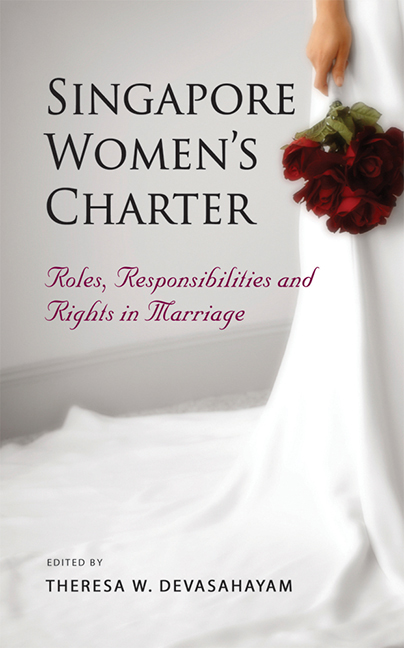Book contents
- Frontmatter
- Contents
- Contributors
- Foreword
- Keynote Address
- 1 Legal Mechanisms for Protecting Women's Rights: Examples from Southeast Asia
- 2 The Women's Charter, 1961: Where We Were Coming From and How We Got There
- 3 Significant Provisions in the Women's Charter
- 4 A Lawyer's Perspective on How Divorcees View the Women's Charter
- 5 “The Morning After”: Understanding and Exploring the Psychosocial Impact of the Women's Charter on Families Experiencing Domestic Violence
- 6 Epilogue: Some Thoughts on Protecting Women's Rights in the Family and Beyond
- Index
1 - Legal Mechanisms for Protecting Women's Rights: Examples from Southeast Asia
Published online by Cambridge University Press: 21 October 2015
- Frontmatter
- Contents
- Contributors
- Foreword
- Keynote Address
- 1 Legal Mechanisms for Protecting Women's Rights: Examples from Southeast Asia
- 2 The Women's Charter, 1961: Where We Were Coming From and How We Got There
- 3 Significant Provisions in the Women's Charter
- 4 A Lawyer's Perspective on How Divorcees View the Women's Charter
- 5 “The Morning After”: Understanding and Exploring the Psychosocial Impact of the Women's Charter on Families Experiencing Domestic Violence
- 6 Epilogue: Some Thoughts on Protecting Women's Rights in the Family and Beyond
- Index
Summary
Introduction
With increasing levels of economic development in countries across the world, the assumption is that there would be greater equality between men and women in every facet of life. It is no longer a surprise to see women making a mark in the public sphere: there are women in high-level positions in government, the private sector, including banking and financial services, international organizations, and others. But women would not have come thus far without the endorsement of the state through the installation of laws and policies engendering equality between the sexes. Most countries have in place national laws to protect women's rights, in addition to having ratified the most distinct international human rights instrument related to women — the UN Convention on the Elimination of All Forms of Discrimination Against Women (CEDAW). Others have complemented their legislation and their support of CEDAW with targeted programmes to eliminate any discrimination against women.
In spite of these efforts, there have been mixed findings reported on women's advancement in many countries across the world — whether it is in education, employment, health, or matters in the private domain such as domestic violence. For example, “violence against women and sexual exploitation remain serious problems …”, according to a CEDAW report. Only eighty-nine member states of the United Nations have legislative provisions for addressing domestic violence as of 2006 and, of this number, sixty states have specific domestic violence laws while others have mapped out clear national plans on this issue. Clearly, not all governments have conscientiously installed the relevant legislation to protect women, drawing criticisms from some human rights quarters which accuse “[some] governments [of] not living up to their promises …”. In response, these governments have evoked the “separate sphere ideology”, maintaining that some issues are related to the private domain in which governments should not interfere (Mertus 1995, p. 135).
- Type
- Chapter
- Information
- Singapore Women's CharterRoles, Responsibilities and Rights in Marriage, pp. 1 - 42Publisher: ISEAS–Yusof Ishak InstitutePrint publication year: 2011



